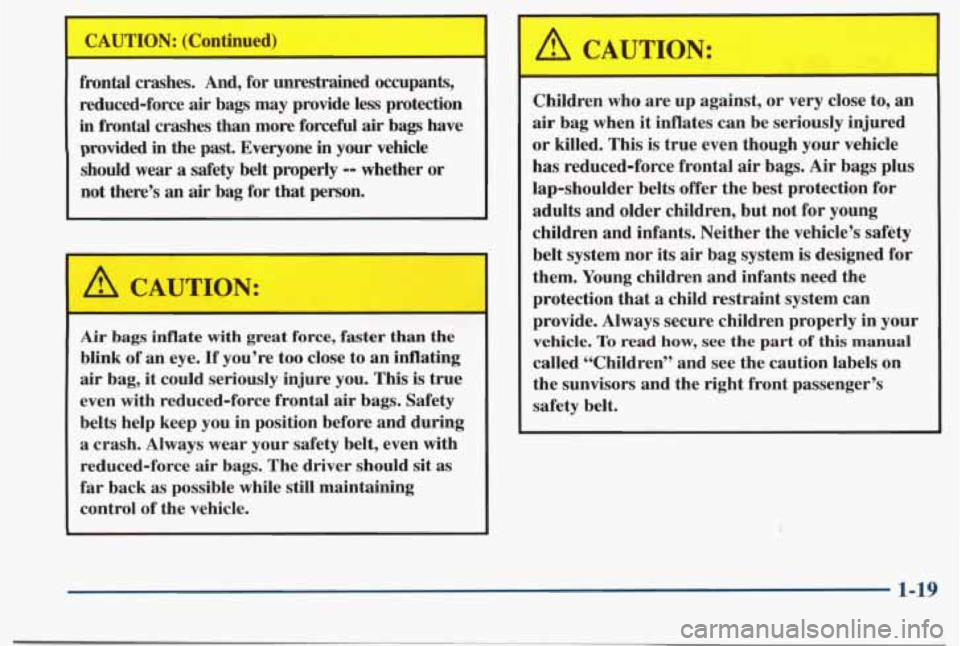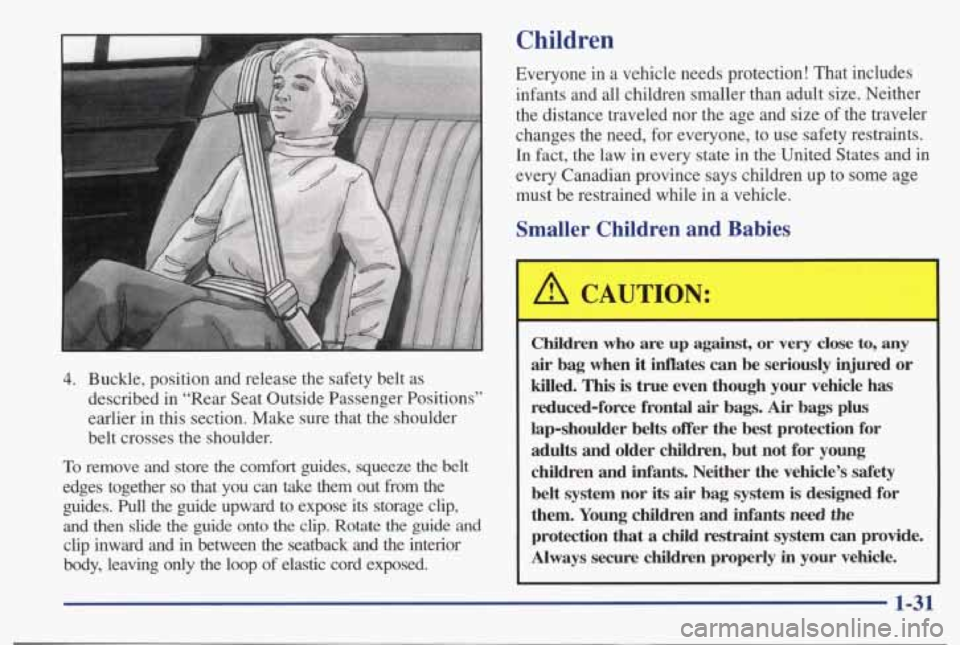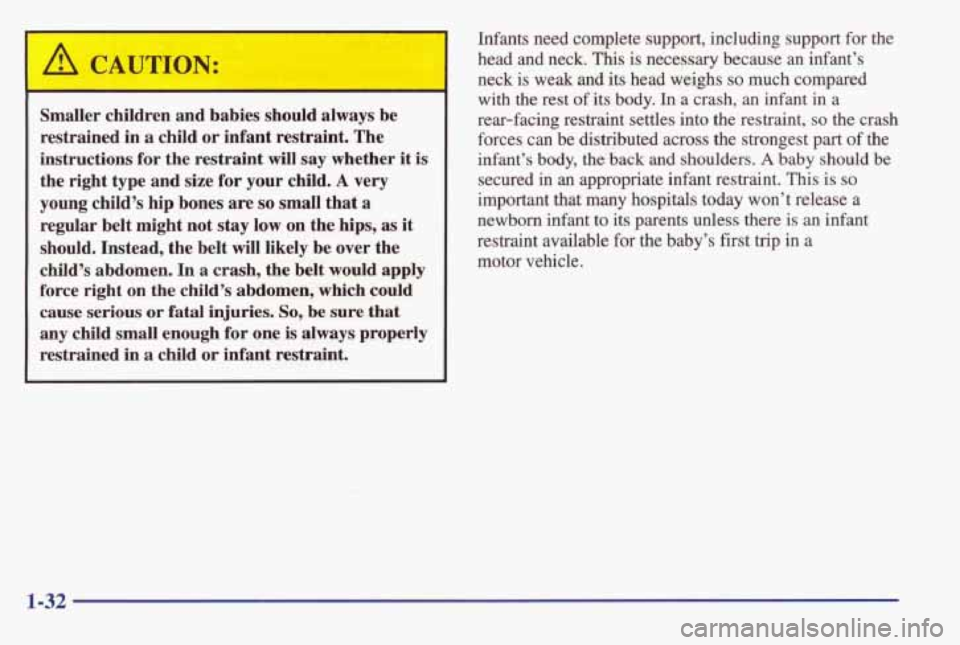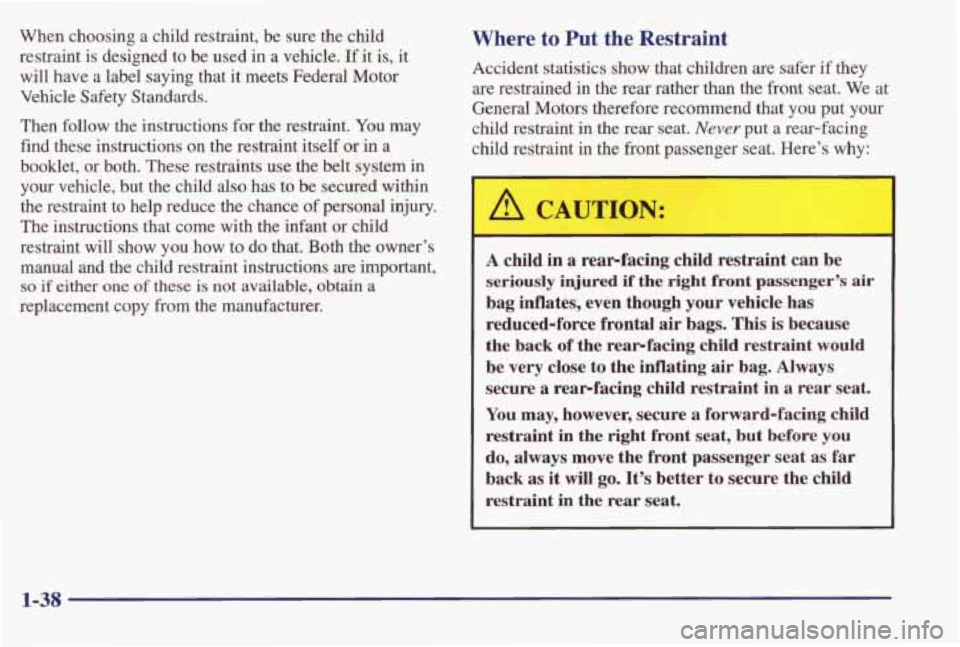Page 18 of 395
“ .”. .. -.
3. Pick up the latch plate and pull the belt across you.
4. Push the latch plate into the buckle until it clicks.
Don’t let
it get twisted.
Pull up on the latch plate to make sure it
is secure. If
the belt isn’t long enough, see “Safety Belt
Extender” at the end
of this section.
Make sure the release button on the buckle is
positioned
so you would be able to unbuckle the
safety belt quickly
if you ever had to. The lap part of the belt should
be worn low and snug on
the hips, just touching the
thighs. In a crash, this applies
force to the strong pelvic bones.
And you’d be less likely
to slide under the lap
belt. If you slid under it, the belt
would apply force at your abdomen.
This could cause
serious or even fatal injuries. The shoulder belt
should go
over the shoulder and across the chest. These parts of the
body are best able to take belt restraining forces.
The safety belt locks if there’s a sudden stop or crash.
1-11
Page 26 of 395

frontal crashes. And, for unrestrained occupants,
reduced-force
air bags may provide less protection
in frontal crashes than more forceful air bags have
provided
in the past. Everyone in your vehicle
should
wear a safety belt properly -- whether or
not there’s an
air bag for that person.
I
&A CAUTION:
Air bags inflate with great force, faster than the
blink of an eye.
If you’re too close to an inflating
air bag, it could seriously injure you. This is true
even with reduced-force frontal air bags. Safety
belts help keep you in position before and during
a crash. Always wear your safety belt, even with
reduced-force air bags. The driver should sit as
far back as possible while still maintaining
control of the vehicle.
’ A CAUTION:
Children who are up against, or very close to, an
air bag when it inflates can be seriously injured
or killed. This is true even though your vehicle
has reduced-force frontal air bags. Air bags plus
lap-shoulder belts offer the best protection for
adults and older children, but not for young
children and infants. Neither the vehicle’s safety
belt system nor its air bag system is designed for
them. Young children and infants need the
protection that a child restraint system can
provide. Always secure children properly
in your
vehicle. To read how, see the part of this manual
called “Children” and see the caution labels on
the sunvisors and the right front passenger’s
safety belt.
i
1-19
Page 34 of 395
- .. .. . . .. . . .. .. . . . . .. . . . . . . . .... . . . . .. . . .. .
If the belt stops before it reaches the buckle, tilt the
latch plate and keep pulling until you can buckle
it.
Pull up on the latch plate to make sure it is secure.
If the belt is not long enough, see “Safety Belt
Extender” at the end of
this section. Make sure the
release button on the buckle is positioned
so you
would be
able to unbuckle the safety belt quickly if
you ever had to.
b
3. To make the lap part tight, pull down on the buckle
end of the belt as you pull up on the shoulder
part.
1-27
Page 38 of 395

4. Buckle, position and release the safety belt as
described in “Rear Seat Outside Passenger Positions’’
earlier in this section. Make sure that the shoulder
belt crosses the shoulder.
To remove and store the comfort guides, squeeze the belt
edges together so that you can take them out Erom the
guides.
Pull the guide upward to expose its storage clip,
and
then slide the guide onto the clip. Rotate the guide and
clip inward and in between
the seatback and the interior
body, leaving only the loop of elastic cord exposed.
Children
Everyone in a vehicle needs protection! That includes
infants and all children smaller than adult size. Neither
the distance traveled nor the age and size of
the traveler
changes the need, for everyone, to use safety restraints.
In fact, the law in every state in the United States and in
every Canadian province says children up to some age
must be restrained while in
a vehicle.
Smaller Children and Babies
I
A CAUTION:
- -
Children who are up against, or very close to, any
air bag when it inflates can be seriously injured or
killed. This is true even though your vehicle has
reduced-force fmntal
air bags. Air bags plus
lap-shoulder belts offer the best protection for
adults
and older children, but not for young
children
and infants. Neither the vehicle’s safety
belt system nor its
air bag system is designed for
them. Young children
and infants need the
protection that a child restraint system can provide.
Always secure children properly in your vehicle.
1-31
Page 39 of 395

’ A CAUTION:
Smaller children and babies should always be restrained
in a child or infant restraint. The
instructions for the restraint
will say whether it is
the right type and size for your child.
A very
young child’s
hip bones are so small that a
regular belt might not stay low on the hips, as it
should. Instead, the belt
will likely be over the
child’s abdomen.
In a crash, the belt would apply
force right on the child’s abdomen,
which could
cause serious or fatal injuries. So, be sure that
any child small enough for one is always properly
restrained
in a child or infant restraint.
Infants need complete support, including support for the
head and neck.
This is necessary because an infant’s
neck is weak and its head weighs
so much compared
with
the rest of its body. In a crash, an infant in a
rear-facing restraint settles into the restraint,
so the crash
forces can be distributed across the strongest part of the
infant’s body, the back
and shoulders. A baby should be
secured in an appropriate infant restraint. This is so
important that many hospitals today won’t release a
newborn infant to its parents unless there is
an infant
restraint available
for the baby’s first trip in a
motor vehicle.
1-32
Page 40 of 395
I
Never hold a baby in your arms while riding in a
vehicle. A baby doesn’t weigh much -- until a
crash. During a crash a baby will become so
heavy you can’t hold it. For example, in a crash
CAUTION: (Continued) at
only 25 mph
(40 km/h), a 12-1b. (5.5 kg) baby
will suddenly become a 2404b. (110 kg) force on
your arms. The baby would be almost impossible
to hold.
Secure the baby in an infant restraint.
A
1-33
Page 42 of 395
A rear-facing infant restraint (B) positions an infant
to face the rear
of the vehicle. Rear-facing infant
restraints are designed
for infants of up to about
20 lbs. (9 kg) and about one year of age. This type
of restraint faces the rear
so that the infant’s head,
neck
and body can have the support they need in a
crash. Some infant seats come in two parts -- the
base stays secured in the vehicle and the seat part
is removable.
1-35
Page 45 of 395

When choosing a child restraint, be sure the child
restraint is designed to be used in a vehicle.
If it is, it
will have a label saying that it meets Federal Motor
Vehicle
Safety Standards.
Then follow the instructions for the restraint.
You may
find these instructions on the restraint itself or
in a
booklet, or
both. These restraints use the belt system in
your vehicle, but the child also has to be secured within
the restraint to help reduce the chance of personal injury.
The instructions that come with the infant or child
restraint will
show you how to do that. Both the owner’s
manual and the child restraint instructions
are important,
so if either one of these is not available, obtain a
replacement copy
from the manufacturer.
Where to Put the Restraint
Accident statistics show that children are safer if they
are restrained
in the rear rather than the front seat. We at
General Motors therefore recommend that you put
your
child restraint in the rear seat. Never put a rear-facing
child restraint in
the front passenger seat. Here’s why:
A child in a rearfacing child restraint can be
seriously injured if the right front passenger’s air
bag inflates, even though your vehicle has
reduced-force frontal
air bags. This is because
the
back of the rearfacing child restraint would
be very close to the inflating air bag. Always
secure a rearfacing child restraint in a rear seat.
You may, however, secure a forward-facing child
restraint in the right front seat, but before
you
do, always move the front passenger seat as far
back
as it will go. It’s better to secure the child
restraint
in the rear seat.
1-38